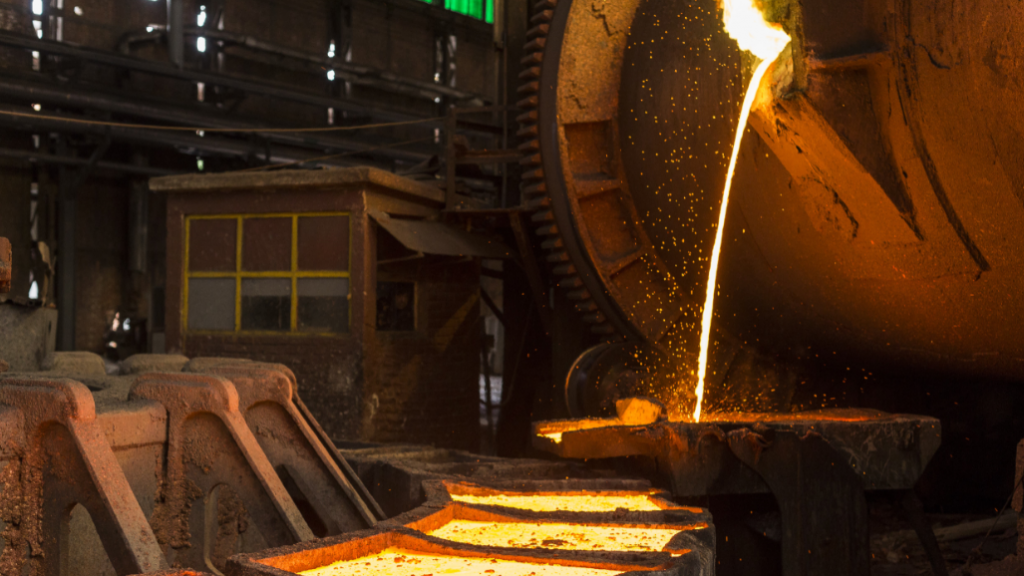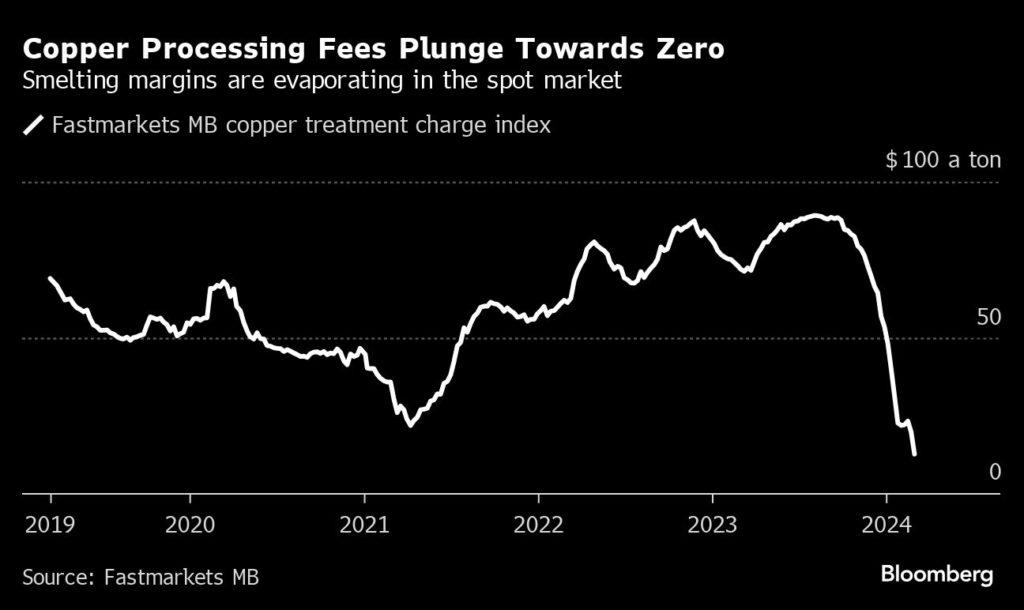
China’s copper smelters are at a critical juncture after fees for processing imported ore collapsed to single figures, raising focus on whether they will keep resisting pressure for production cuts.
A steep decline in so-called treatment and refining charges has accelerated in March, with copper concentrate trading at levels more than 90% lower in the spot market than six months ago. That means squeezed margins or losses for smelters, and points to a sharp tightening of the market after a series of unexpected mine disruptions.
Cargoes of copper concentrate from BHP Group Ltd.’s giant Escondida mine in Chile changed hands recently at terms as low as $12 a metric ton and 1.2 cents a pound to Chinese smelters, and at $3 and 0.3 cents to at least one trader, according to people familiar with the deals. BHP declined to comment.

Fees last dropped to single digits in 2010, in the aftermath of the global financial crisis, according to researcher Wood Mackenzie. Next week, executives from at least 15 Chinese smelters are set to gather to Beijing next week to discuss how to combat the lower fees, including potential production curbs.
“The current spot fees have been significantly lower than the smelter’s break-even point and we expect larger production cuts or lower operating rates of Chinese smelters in the next few months,” said Brian Peng, a Beijing-based senior analyst with researcher CRU. Smelters could also start routine maintenance ahead of schedule, he said.
Low treatment fees are a kind of stress signal in the global copper market, and will be seen by the metal’s more bullish backers as evidence that a long-anticipated shortage is emerging. Copper’s role in the energy transition is widely expected to leave mines scrambling to keep up with demand, leading to much higher prices this decade.
Still, a major driver of the plunge in fees has been a rapid expansion of copper smelting capacity — centered in China, but also in India and Indonesia. That means the lower treatment fees won’t necessarily translate to higher metals prices, especially if Chinese smelters refrain from making steep output cuts.
“This has less to do with a lack of mine-supply growth, and more to do with an excess of smelting capacity, said David Wilson, senior commodity strategist at BNP Paribas. “That overhang of smelting capacity isn’t something that’s going to be particularly helpful for the copper price.”
Global copper demand has taken a hit as industry reels from high energy costs and slow consumer spending. The economic outlook for China — responsible for more than half the market’s copper consumption — remains gloomy, and latest figures from Germany showed a severe slump in January manufacturing orders.
And there are reasons why the unusually low smelter fees might not yet mean swingeing output cuts. The bulk of supply is still priced against annual contract terms, mitigating the impact of spot prices. Nearly all of China’s copper industry is now state-owned, and may prefer to maintain production and eat the losses on spot, some analysts said.
“Miners are testing the bottom line at smelters, while smelters seem to not really have a bottom line,” Wang Yingying, analyst with Galaxy Futures Co., said by phone. “It may eventually require the gains in copper prices to spur more supply of copper scrap to resolve the current difficulties.”
The fee plunge comes just a few months after benchmark contracts for annual concentrate supply were settled between Chilean mining company Antofagasta Plc and Chinese smelter Jinchuan Group at $80 per ton and 8 cents per pound — 9% lower than in 2023 but still reflecting a relatively balanced copper market.
Since then, a $10 billion copper mine in Panama owned by First Quantum Ltd. was ordered to close after weeks of protests and political turmoil, while supply from other producers including Anglo American Plc has also been crimped.
Low processing fees are compounded by mediocre revenue streams elsewhere for smelters. Spot premiums for copper cathode have returned to around their five-year average at $60 per tonne in Shanghai. Prices for sulfuric acid — a byproduct of the smelting process that is used as a base for fertilizers — are at very low levels and not offering much relief, executives at copper smelters said.
“Smelter margins on an aggregate basis are okay, because they have enough volumes booked on on contract terms,” said Macquarie’s head of commodities strategy Marcus Garvey. “But on a spot basis, I’ve would have thought almost everyone would be loss-making, and that’s inherently not sustainable.”
This burst of new smelting capacity means terms will take a long time to return to higher levels, said Albert De Sousa, an industry veteran who managed marketing desks for BHP and Newcrest Mining Ltd., now part of Newmont Corp. Competition among traders and smelters for feedstock is bleeding into gold concentrate and low-grade copper concentrate markets, he noted.
“The elephant in the room has been here for a while. It’s not leaving anytime soon,” De Sousa said.
(By Archie Hunter and Alfred Cang)
Comments